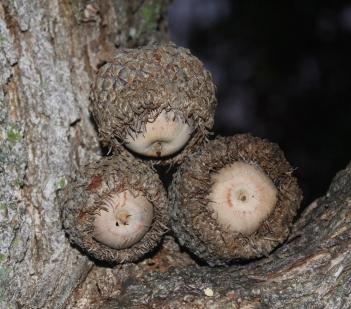Oak; Texas Red Oak Quercus texana Buckl; Most of Texas is too dry for the straight Northern Red Oak preferred by home-owners, and the sun is so intense it can sunburn its smooth bark. Locally, Texas Oak takes the place of Red Oak, both in terms of the color of its wood, the shape of its acorns, and the shape of its leaves. The deeply cut lobes of deciduous Texas Red Oak leaves, like the Red Oak, end in sharp points, but it grows from a heavy bulbous base (a drought tolerant feature), supporting multiple trunks, and its black, corky, ridged bark protects it from the sun. The tree is subject to viral wilt which kills trunks of stressed trees at about 4’, turning their heart wood to mush. New trunks sprout from the base, and new shoots grow from trunks, giving the tree a “shabby” look, but eventually the tree dies. Texas Red Oak reproduces via catkins of tiny flowers, which convert into clusters of blunted, egg-shaped, light brown held in a shallow, nearly flat cap. Catkins bud from the tips of last year’s stems, just before new growth begins to bud in. Tiny wasps lay eggs between the layers of Q. texana leaves, which the tree surrounds, with a hard, seed-like coating, suspending it in white fibers, producing a green. The local name “Red” Oak comes from the reddish color of the highly desired, straight grained, heart-wood, which has a peculiar, though not unpleasant, sour smell when freshly split. Acorn weevils drill pin-prick holes in the light brown acorns, and the grubs eat out the nut, emerging through holes the size of pencil lead, drilling into the soil where they finish molting. Drilled acorns are filled with black crud and are not viable. (192-193) 4/1/15; 2/23/16; 3/8/17-3/20/17; 3/18/18; 3/20/19-4/1/19; 3/5/20 – 3/28/20;

Texas Red Oak habit; a deciduous, crown tree that often has multiple trunks rising from a bulbous base, sometimes with new suckers sprouting from it, bearing pinnate leaves cut by deep sinuses, each lobe with a sharp tip, and producing egg-shaped, brown acorns
Note; black, corky, deeply furrowed bark that gives Texas Oak protection from the sun and drought.
Note; the bulbous base shared by multiple trunks, which readily sprouts new shoots

Note; alternating, pinnate leaves cut by deep, rounded sinuses, each lobe with a sharp point

Note; brown, oval, egg shaped acorns lacking a sharp, terminal spike, with an exit hole from an Acorn Weevil larva

Note; warty, green leaf galls caused by a tiny wasp that lays an egg between the layers of the leaf, filled with white filaments that support a hard core.


Note; leaves turn dark red in the fall


































